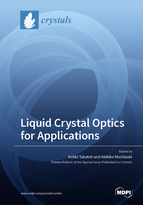Liquid Crystal Optics for Applications
A special issue of Crystals (ISSN 2073-4352). This special issue belongs to the section "Liquid Crystals".
Deadline for manuscript submissions: closed (31 January 2022) | Viewed by 24795
Special Issue Editors
Interests: liquid crystal device; liquid crystal materials; optical films; low driving technology; liquid crystal polymer; liquid crystal monomer; liquid crystal alignment
Special Issues, Collections and Topics in MDPI journals
Special Issue Information
Dear Colleagues,
Since the discovery of liquid crystalline (LC) material in 1888, the optical properties of LC materials have been attracting much interest. In particular, the impressive image due to the birefringence under polarized microscope has stimulated the intellectual curiosity of many scientists. The situation changed drastically after the success of the application to display devices in 1960s. Huge amounts of research using LC materials aimed at display applications have been carried out. Research has been pursued aggressively, not only for displays but also for other kinds of applications, based on the optics of liquid crystals. For example, the application for glasses has been studied since the early stage of LC research, and some kinds of LC glasses have been commercialized. A wide variety of applications of LC devices has been proposed, such as smart windows for architectures and vehicles, laser equipment, LiDar for EV, and so on.
The aim of this Special Issue is to provide the opportunity to overview technologies based on the optics of liquid crystals.
Prof. Dr. Kohki Takatoh
Dr. Akihiko Mochizuki
Guest Editors
Manuscript Submission Information
Manuscripts should be submitted online at www.mdpi.com by registering and logging in to this website. Once you are registered, click here to go to the submission form. Manuscripts can be submitted until the deadline. All submissions that pass pre-check are peer-reviewed. Accepted papers will be published continuously in the journal (as soon as accepted) and will be listed together on the special issue website. Research articles, review articles as well as short communications are invited. For planned papers, a title and short abstract (about 100 words) can be sent to the Editorial Office for announcement on this website.
Submitted manuscripts should not have been published previously, nor be under consideration for publication elsewhere (except conference proceedings papers). All manuscripts are thoroughly refereed through a single-blind peer-review process. A guide for authors and other relevant information for submission of manuscripts is available on the Instructions for Authors page. Crystals is an international peer-reviewed open access monthly journal published by MDPI.
Please visit the Instructions for Authors page before submitting a manuscript. The Article Processing Charge (APC) for publication in this open access journal is 2600 CHF (Swiss Francs). Submitted papers should be well formatted and use good English. Authors may use MDPI's English editing service prior to publication or during author revisions.
Keywords
- Liquid crystal
- Optics
- Applications
- Birefringence
- Retardation
- Light waveguide
- Optical switching







